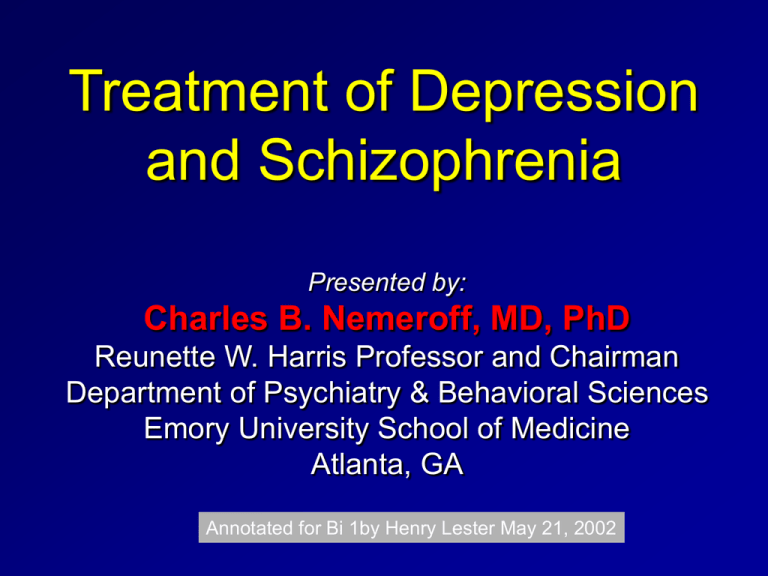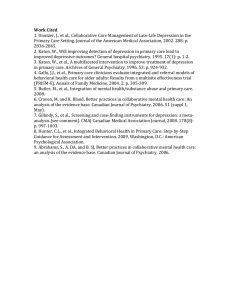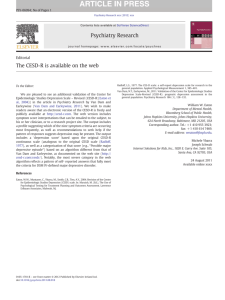
Treatment of Depression
and Schizophrenia
Presented by:
Charles B. Nemeroff, MD, PhD
Reunette W. Harris Professor and Chairman
Department of Psychiatry & Behavioral Sciences
Emory University School of Medicine
Atlanta, GA
Annotated for Bi 1by Henry Lester May 21, 2002
Canst thou not minister to a mind diseased?
Pluck from the memory a rooted sorrow,
Raze out the written troubles of the brain,
And with some sweet oblivious antidote
Cleanse the stuffed bosom of that perilous
Stuff which weighs upon the heart?
MACBETH
All his life he suffered spells of depression, sinking
into the brooding depths of melancholia, an
emotional state which, though little understood,
resembles the passing sadness of the normal man
as a malignancy resembles a canker sore.
William Manchester,
The Last Lion, Winston Spencer Churchill, Vol. I: Visions of Glory
(New York: Little, Brown & Company, 1989, p. 23)
Major Depressive Episode:
DSM-IV Diagnostic Criteria
• Characterized by clinically significant distress
•
and/or impairment in social, occupational, or other
important areas of functioning
Symptoms must persist for most of day, nearly
every day, for 2 consecutive weeks
DSM-IV. 1994.
Prevalence of Depression in United States
6%-25%
Point Prevalence
of Major Depression (%)
25
20
15
10%-14%
5%-10%
10
5
2%- 4%
0
Community
Primary Care
Clinic
Katon W. Schulberg H. Gen Hosp Psychiatry. 1992; 14: 237-247
Medical
Inpatient
Setting
Nursing Home
DSM-IV Diagnostic Criteria for
Major Depression
• 5 symptoms including depressed mood and/or anhedonia
-
•
-
Other symptoms may include:
Significant weight change
Psychomotor agitation/retardation
Pervasive loss of energy/fatigue
Feelings of worthlessness/excessive or inappropriate
guilt
Difficulty concentrating
Sleep disturbance
Recurrent thoughts of death/suicide
Symptoms present for 2 weeks
DSM-IV. 1994.
Epidemiology of Major Depression
• 17% of US population reported a major
depressive episode in their lifetime
• Average age of onset: late 20s
- >50% of patients have first episode by
age 40
• Duration: 6 months – 2 years if left untreated
- Episodes continue in up to 80% of
untreated patients
Depression Guideline Panel. Depression in Primary Care: Vol 1. Detection and Diagnosis. Clinical Practice
Guideline No. 5. 1993.
“He asked me if I was suicidal, and I reluctantly told him yes. I did
not particularize -- since there seemed no need to -- did not tell him
that in truth many of the artifacts of my house had become
potential devices for my own destruction: the attic rafters (and an
outside maple or two) a means to hang myself, the garage a place
to inhale carbon monoxide, the bathtub a vessel to receive the flow
form my open arteries. The kitchen knives in their drawers had but
one purpose for me. Death by heart attack seemed particularly
inviting, absolving me as it would of responsibility, and I had toyed
with the idea of self-induced pneumonia -- a long, frigid, shirt
sleeved hike through the rainy woods. Nor had I overlooked an
ostensible accident, a la Randall Jarrell, by walking in front of a
truck on the highway nearby. These thoughts may seem
outlandishly macabre -- a strained joke -- but they are genuine.
They are doubtless especially repugnant to healthy Americans,
with their faith in self-improvement. Yet in truth such hideous
fantasies, which cause well people to shudder, are to the deeply
depressed mind what lascivious daydreams are to persons of
robust sexuality.”
William Styron, Darkness Visible: A Memoir of Madness, 1990.
Global Burden of Disease and Injury Series
THE GLOBAL BURDEN
OF DISEASE
A comprehensive assessment of mortality and
disability from diseases, injuries, and risk
factors in 1990 and projected to 2020
EDITED BY
CHRISTOPHER J. L. MURRAY
Harvard University
Boston, MA, USA
ALAN D. LOPEZ
World Health Organization
Geneva, Switzerland
Published by The Harvard School of Public Health on behalf of
The World Health Organization and The World Bank
Distributed by Harvard University Press
Leading Causes of Disability, World, 1990
Total
(millions)
472.7
Per cent
of total
1) Unipolar major depression
50.8
10.7
2) Iron-deficiency anaemia
22.0
4.7
3) Falls
22.0
4.6
4) Alcohol Use
15.8
3.3
5) Chronic obstructive pulmonary disease
14.7
3.1
6) Bipolar Disorder
14.1
3.0
7) Congenital anomalies
13.5
2.9
8) Osteoarthritis
13.3
2.8
9) Schizophrenia
12.1
2.6
10) Obsessive-compulsive disorders
10.2
2.2
All Causes
The leading causes of disease burden
for women, aged 15-44, 1990
Percent of all causes in developed or developing regions
CAUSES
Unipolar major depression
Schizophrenia
Road traffic accidents
Bipolar disorder
Obsessive-compulsive disorder
Alcohol use
Osteoarthritis
Chlamydia
Self-inflicted injuries
Rheumatoid arthritis
Tuberculosis
Iron-deficiency anaemia
Obstructed labour
Maternal sepsis
War
Abortion
The burdens of mental illness, such as depression,
alcohol dependence, and schizophrenia, have
been seriously underestimated by traditional
approaches that take account only of deaths and
not disability. While psychiatric conditions are
responsible for little more than one per cent of
deaths, they account for almost 11 per cent of
disease burden worldwide.
Depression harms more women than AIDS or cancer
In 1990, suicide was the number-one cause of death
and disability for women ages 15 to 44 worldwide. By the
year 2020, it will rank second only to heart disease as the
world’s leading cause of death and disability for men and
women of all ages, predicts a five-year study by the World
Health Organization, the World Bank and the Harvard
School of Public Health.
Among adults aged 15 – 44 worldwide, road traffic
accidents were the leading cause of death for men and the
fifth most important for women. For women aged between
15 – 44, suicide was second only to tuberculosis as a
cause of death. In China alone, more than 180,000 women
killed themselves in 1990. In India, women face an
appallingly high risk of dying in fires: in 1990 alone, more
than 87,000 Indian women died this way. In Sub-Saharan
Africa, by contrast, the most important cause of injury
deaths for both women and men is war.
Depressive Disorders in Children
Prevalence of Depressive Disorders in Children*
•
•
•
Preschool children – 0.8%
School-aged prepubertal children – 2.0%
Adolescents – 4.5%
Key Issues†
•
•
•
Distinguish between depressive disorders and
behavioral disorders
Depressive disorders before age 20 often associated
with recurrent mood disorders in adulthood
30% of adolescents hospitalized with severe major
depressive disorder develop bipolar disorder
*Weller EB, Weller RA. In: Psychiatric Disorders in Children and Adolescents. 1990: 3-20.
†Depression Guideline Panel. Depression in Primary Care: Volume 1. Detection and Diagnosis. 1993: 1-65.
Giles DE, Jarrett RB, Biggs MM, et al. Am J Psychiatry. 1989; 146: 765-767.
Strober M, Carlson G. Arch Gen Psychiatry. 1982; 39: 549-555.
Rates of Completed Suicide*
80
70
Male
Female
60
50
No. of
Suicides 40
Per 100,000
30
20
10
0
Age (years)
*In the United States, 1994.
Reproduced with permission from Hirschfeld RMA and Russell JM. N Engl J Med. 1997;337:910-915.
© Copyright 1997, Massachusetts Medical Society. All rights reserved.
Postpartum Depression (PPD)
• 10% to 15% in adults*
• 26% of adolescents†
• Second in frequency only
to C-section
*Stowe and Nemeroff. Am J Obstet Gynecol. 1995; 173: 639-645.
†Troutman and Cutrona. J Abnorm Psychol. 1990; 99: 69.
Depressive Disorders After Miscarriage
• >33% severely depressed*
• duration of pregnancy = risk of
depressive disorder*
• Treat depressive disorders if reaction
beyond expected grief and bereavement
*from Janssen et al. Am J Psychiatry. 1996; 153: 226-30.
Anxiety Disorders
Panic
Disorder
Specific
Phobias
Social
Phobia
Generalized
Anxiety
Disorder
Posttraumatic
Stress
Disorder
Comorbid Depressive Disorder
ObsessiveCompulsive
Disorder
Depressive Disorders in Older Age
• Occur in approximately 15% of
population >65 years old
• May mimic dementia
• Comorbid somatic symptoms
• Not due to “old age”
• Require appropriate treatment
Data from NIH Consensus Development Panel on Depression in Late Life. JAMA. 1992; 288: 1018-24.
Current Treatment Options
for Depression
Goal = reduce symptoms of depression and return patient
to full, active life
Nonpharmacologic
• Psychotherapy
- Cognitive behavioral
Pharmacologic
• Antidepressant
medications
therapy
- Interpersonal therapy
- Psychodynamic therapy
• Electroconvulsive therapy
• Phototherapy
Depression Guideline Panel. Depression in Primary Care: Vol 1. Detection and Diagnosis. Clinical Practice Guideline
No. 5. 1993.
STEPS: Factors to Consider in
Antidepressant Selection
• Safety
- Drug-drug interaction potential
• Tolerability
- Acute and long term
• Efficacy
- Onset of Action
- Treatment and prophylaxis
• Payment (cost-effectiveness)
• Simplicity
- Dosing
- Need for monitoring
Preskorn SM. J Clin Psychiatry. 1997; 58(suppl 6): 3-8.
Pharmacotherapy of Depression
Antidepressant agent classes
• Monoamine oxidase inhibitors (MAOIs)
• Tricyclic (TCAs) and tetracyclic
•
•
antidepressants
Selective serotonin reuptake inhibitors
(SSRIs)
Atypical antidepressants
- Bupropion
- Venlafaxine
- Nefazodone
- Mirtazapine
Rossen EK, Buschmann MT. Arch Psychiatr Nurs. 1995; 9: 130-136.
Evidence for the Undertreatment of
Depressive Disorders
Medical Outcomes Study
N = 634
Minor tranquilizer
only
19%
No antidepressant
or tranquilizer
59%
12%
Antidepressant*
only
11%
Antidepressant*
and minor
tranquilizer
*39% of patients using antidepressants were receiving subtherapeutic doses
Data are rounded to nearest percentage
Adapted from Wells KB, Katon W, Rogers B, et al. Am J Psychiatry. 1994; 151: 694-700.
Outcome of Depression Treatment
The Five Rs
Remission
Recovery
Relapse
Recurrence
Response
x
x
Symptoms
Syndrome
Treatment Phases
x
Acute
6-12 Weeks
Continuation
4-9 Months
Maintenance
?1 Year
Reproduced with permission from Kupfer DJ. J Clin Psychiatry. 1991;52(suppl 5):28-34.
Copyright 2002, Physicians Postgraduate Press.
Depression: Recurrence Risks
1 Episode
50%
2 Episodes
80% - 90%
3 Episodes
>90%
Depression Guideline Panel. Depression in Primary Care, Volume 2: Treatment of Major Depression.
Clinical Practice Guidelines, Number 5. 1993.
Kupfer DJ. J Clin Psychiatry. 1991;52(suppl 5):28-34.
Recurrent
Depression:
Treatment
Implications
Continue antidepressant
for first 4 - 9 months
Continue antidepressant
indefinitely after
3 episodes or
2 episodes in patients
with risk factors
Depression Guideline Panel. Depression in Primary Care, Volume 2: Treatment of Major
Depression. Clinical Practice Guidelines, Number 5. 1993.
Schulberg HC et al. Arch Gen Psychiatry. 1998;55:1121-1127.
Primary Care Patients with Depression
% of Patients Who Filled Antidepressant
Prescriptions
Usual Care
Intervention Group
100
80
*
60
% of
Patients
40
20
0
0 to 3
3 to 6
6 to 9
Time Period (months)
* P<.001; statistical significance assessed only at 1 year.
Katon W et al. Arch Gen Psychiatry. 2001;58:241-247.
9 to 12
Primary Care Patients with Depression
Discontinuation Rate of Antidepressant
Medication
100
80
% of
Patients
Discontinuing
Medication
60
40
20
0
0
4
8
12
Weeks After Medication Initiation
Adapted with permission from Lin EHB et al. Med Care. 1995;33:67-74.
16
SSRIs Available for Treatment of
Depression in the United States
• Fluoxetine:
• Paroxetine:
• Sertraline:
• Citalopram:
Prozac®, Eli Lilly
Paxil®, GlaxoSmithKline
Zoloft®, Pfizer
CelexaTM, Forest & Parke-Davis
Physicians’ Desk Reference. 1998.
Celexa Package Insert. Forest Pharmacueticals, Inc.
SSRI Structures
O
NC
O
HN
CH3
O
O
CH2CH2CH2N(CH3)2 HBr
CH2
Paroxetine
Citalopram
F
N
Cl
F3C
C CH2 CH2 CH2 CH2 O CH3
Cl
O
Sertraline
N
Fluvoxamine
H
C
O CH2 CH2 NH2
Celexa package insert, Forest Laboratories, Inc.
Physicians’ Desk Reference. 1998.
Fluoxetine
CH2CH2N
CH3
H
% Patients with >50% Reduction
in Baseline HAMD Total Score
Response to Paroxetine and Fluoxetine
in Patients with Major Depression
70
60
50
Paroxetine
(N=37)
Fluoxetine
(N=41)
*
40
30
20
10
0
Wk 1
*P<.05
DeWilde et al. Acta Psychiar Scand. 1993; 87: 141
Wk 3
Wk 4
Wk 6
Proportion Remaining Well
Relapse of Depression During
Continuation Study of Sertraline
Days of Continuation Treatment
Doogan et al. Br J Psychiatry. 1992; 160: 217
SSRIs:
Tolerability
Issues
Early-onset effects
(headache, GI)
Sexual dysfunction
Weight change
Discontinuation
Drug interactions
Most Common Adverse Effects
Paxil
(N=4126)
• Nausea
• Headache
• Somnolence
• Dry Mouth
• Insomnia
23%
18%
17%
17%
13%
Prozac
(N=2938)
• Nausea
• Headache
• Nervousness
• Insomnia
• Anxiety
Boyer et al. J Clin Psychiatry. 1992; 53 (suppl 2):61.
Doogan. Int Clin Psychopharmacol. 1991; 6(suppl 2): 47.
Stokes. Clin Ther. 1993; 15: 216.
23%
18%
17%
16%
13%
Zoloft
(N=4126)
• Nausea
21%
• Headache 18%
• Dry Mouth 16%
• Diarrhea/Loose
Stools
• Insomnia
15%
14%
SSRIs and Sexual Dysfunction
Common, class effect
Affects men and women
Reduced libido
Orgasmic dysfunction
– delayed ejaculation
– anorgasmia
Erection difficulties minimal
Associated with anxiety/depression
Keller Ashton A et al. J Sex Marital Ther. 1997;23:165-175.
Segraves RT. J Clin Psychiatry. 1998;59(suppl 4):48-54.
Strategies for
Antidepressant Nonresponse
Optimization: Full Dose
and Duration
Drug Substitution
Combination: Addition
of Second
Antidepressant Agent
Electroconvulsive Therapy
Augmentation:
Addition of
Second Agent
(Not an
Antidepressant)
Antipsychotic Indications and
Uses
– Schizophrenia/Psychosis
– Bipolar Disorder
Mania
Depression
– Unipolar Depression
Psychotic
Treatment Resistant
– Dementia
Agitation/psychosis
Schizophrenia
Chronic, “lifelong” condition
Very high morbidity
Very high mortality
High personal/family impact
High societal/medical system cost
The Course of Schizophrenia
Affects approximately 1.3% of the population*
Onset generally occurs during young adulthood*
Early treatment predicts better long-term outcomes*
Majority of patients experience at least one relapse†
Higher incidence of comorbid conditions including
hypertension, diabetes, cardiac concern, STDs,
substance abuse disorders, smoking*‡
Mortality higher than in the general population‡
– 10% incidence of suicide‡
*Mental health: a report of the surgeon general. Department of Health and Human Services. December 1999.
†Robinson D, Woerner MG, Alvir JMJ, et al. Arch Gen Psychiatry. 1999;56:241-247.
‡Goldman LS. J Clin Psychiatry. 1999;60(suppl 21):10-15.
Risk of Relapse in Patients With Schizophrenia
Rate of relapse among patients treated with conventional
antipsychotics for first-episode schizophrenia and
schizoaffective disorder
– 16% at 1 year
– 54% at 2 years
– 82% at 5 years
Stable patients were allowed the option to discontinue
antipsychotic medication after 1 year of treatment
The risk for a first and second relapse was almost 5 times
greater than when not taking medication*
– Risk is diminished by maintenance
antipsychotic drug treatment
*Based on a survival analysis of relapse using medication status as a time-dependent covariate.
Source:
Robinson D, Woerner MG, Alvir JMJ, et al. Arch Gen Psychiatry. 1999;56:241-247.
Barriers to Adherence to
Antipsychotic Therapy
Cognitive impairment
Complex drug regimen (eg, BID dosing)
Adverse events (eg, weight gain, EPS, diabetes, QTc
prolongation)
Monitoring of selected adverse events (eg, ECG, blood,
glucose, liver functioning, electrolyte, slit-lamp testing)
Cost of medication
Substance abuse
Source: Perkins DO. J Clin Psychiatry. 1999;60(suppl 21):25-30.
All Antipsychotics
Efficacious, but not perfect
High side effect burden
Potential catastrophic adverse events
Acceptable in the balance between
treatment vs no treatment
Typical Antipsychotics
Discovered by accident
– Chlorpromazine
All cause same side effects
– Byproduct of drug discovery process
Not Obsolete
Atypical Antipsychotics
Discovered by accident
– Clozapine (Clozaril)
Significant improvement over typical
Improved “effectiveness”
Typical vs. Atypical
Typical
–
–
–
–
High D2
Low 5-HT2A
D1=D2
Increases neurotensin in caudate and nucleus accumbens
Atypical
–
–
–
–
High 5-HT2A
a peptide neurotransmitter
Lower D2
Low D1
Increases neurotensin in nucleus accumbens only
Atypical Antipsychotics
Clozapine (Clozaril)
Risperidone (Risperdal, Consta)
Olanzapine (Zyprexa)
Quetiapine (Seroquel)
Ziprasidone (Geodon)
Atypical Antipsychotics
All efficacious
Differing levels of effectiveness
– Patient response characteristics
– Side effects
– Use limitations (Clozapine)
All have significant side effects
– Similar magnitude
– Different specifics
Significant Improvement Across a Full Range
of Symptoms*
Negative
Positive
Hostility/
symptoms excitement symptoms
Mood
Cognition
0.5
0.47
0.0
-0.19
-0.28
-0.65
-0.5
-1.0
Improvement
Mean PANSS change score at Week 1†
0.1
-1.23
-1.28
P<0.025
-1.5
-2.0
-2.56
-2.5
P<0.001
-3.0
-3.5
-3.29
P<0.02
Risperidone (n=85)
-3.16
-3.07
P<0.001
P<0.001
Placebo (n=86)
PANSS=Positive and Negative Syndrome Scale.
*The Positive and Negative Syndrome Scale (PANSS) is a composite scale consisting of items used to assess
overall psychopathology. Conclusions as to efficacy outcomes of individual items should not be drawn.
†6 mg/day.
Source: Marder SR, Davis JM, Chouinard G. J Clin Psychiatry. 1997;58:538-546.
Risperidone Provides Rapid and Sustained Efficacy*
0
-1.0
Improvement
Mean Total PANSS change score
Significant improvement in symptom scores at week 1
Significant improvement maintained through 1 year
-2.0
-3.0
-4.0
-5.0
P<0.001
-6.0
-7.0
Week
P<0.001
1
2
4
12
28
PANSS=Positive and Negative Syndrome Scale.
1-year, double-blind trial (n=365)
– Average dose was 4.9 mg/day at 1 year
*Data on file, 2000. Submitted for publication.
52
Reduction of Hostility in Schizophrenia
Week 1
Week 8
0.5
0.3
0.2
0.1
0.0
-0.1
-0.2
-0.3
-0.4
P<0.001
-0.5
-0.6
Placebo (n=86)
Risperidone (n=85)†
*Change from baseline to weeks 6 and 8 (last observation carried forward).
†
6 mg/day.
PANSS=Positive and Negative Syndrome Scale.
Source:
Marder SR, Davis JM, Chouinard G. J Clin Psychiatry. 1997;58:538-546.
P<0.001
Improvement
Mean PANSS change score*
0.4
Improvement of Symptoms Associated With Cognition*
0.10
0.00
-0.10
-0.15
Improvement
Mean PANSS change score†
-0.05
-0.20
-0.25
-0.30
-0.35
-0.40
P<0.001
-0.45
-0.50
-0.55
P<0.001
-0.60
-0.65
Week 1
2
3
Placebo (n=86)
4
5
6
7
Risperidone (n=85)‡
*Symptoms of disorganized thought from the PANSS scale.
†
Change from baseline to weeks 6 and 8 (last observation carried forward).
‡6 mg/day.
PANSS=Positive and Negative Syndrome Scale.
Source:
Marder SR, Davis JM, Chouinard G. J Clin Psychiatry. 1997;58:538-546.
8
Improvement of Mood* Symptoms in Schizophrenia
0.10
0.00
-0.10
-0.15
-0.20
Improvement
Mean PANSS change score†
-0.05
-0.25
-0.30
-0.35
P<0.025
-0.40
-0.45
-0.50
P<0.001
-0.55
-0.60
-0.65
Week 1
2
3
Placebo (n=86)
4
5
6
7
‡
Risperidone (n=85)
*Symptoms of anxiety/depression from the PANSS scale.
†Change from baseline to weeks 6 and 8 (last observation carried forward).
‡
6 mg/day.
PANSS=Positive and Negative Syndrome Scale.
Source:
Marder SR, Davis JM, Chouinard G. J Clin Psychiatry. 1997;58:538-546.
8
Emerging Safety Concerns With
Selected Antipsychotics
Diabetes
– Glucose elevations
Weight Gain
Cardiac Safety
– QTc prolongation
Weight Change After 10 Weeks on Standard Drug
Doses, Estimated From a Random Effects Model
95% confidence interval
for weight change (kg)
6
5
4
3
Placebo
Conventional antipsychotics
Novel antipsychotics
Nonpharmacologic controls
2
1
0
–1
–2
–3
Allison et al. Am J Psychiatry 156:1686-1696, 1999







